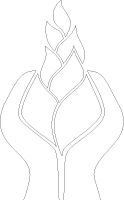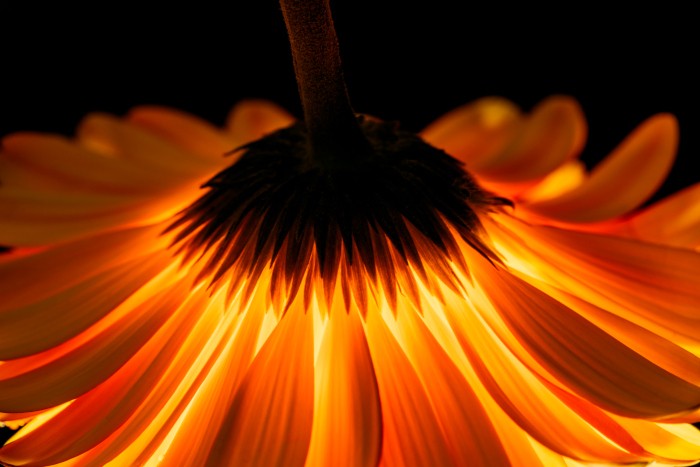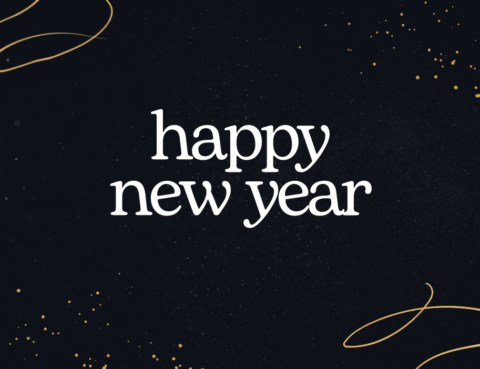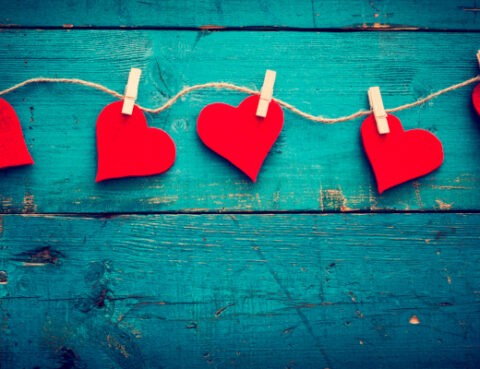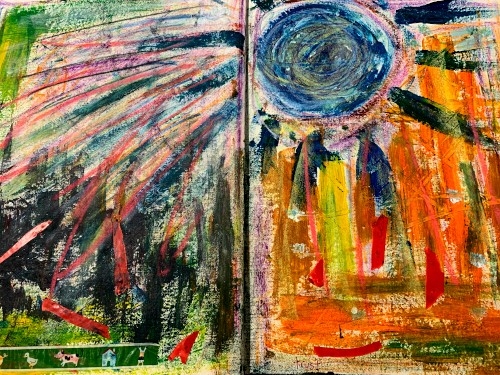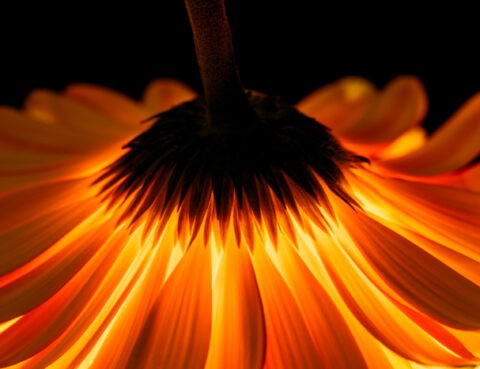
I keep waiting for someone to ask me this. Not even when writing Hold On To Your Kids, over 20 years ago now, did anyone ask me – not my editors or even my most articulate co-writer, Gabor Maté. Perhaps it is obvious and doesn’t require further explanation. On the other hand, the capitalization was a deliberate choice on my part, not just a stylistic preference, and I’d love to have the chance to explain. When looking for other writers in the field of science who also used this convention, I found only a few. I know it is not conventional practice, but still….
Before I indulge myself with giving an explanation that no one is asking for, some clarification is in order about the various meanings of the word ‘nature,’ as only one of the meanings applies here. I am not speaking to the ‘nature’ that refers to the natural world – the plants, animals, weather, and geography that is relatively unspoiled or unaltered by people. When we use ‘nature’ in this way, we are usually referring to that which is neither cultivated or domesticated: forests, meadows, oceans, streams, lakes, wildlife, wind, storms, and so on. Nor am I referring to the word we use when referring to an inherent property or character trait, that is, when it is in someone’s nature to act in a certain way.
There are a number of reasons to capitalize a word, of course. Creating a proper noun is first and foremost an act of naming an entity. The most common example is probably the capitalizing of mom or dad in order to differentiate the role from the particular person we are referring to. In this case, what I needed to do is name the life-force responsible for the spontaneous unfolding of potential. In times past, the word ‘development’ referred to this growth force, but this is hardly the case anymore. Development now typically refers to how things are formed over time, or even worse, to the study of the ages and stages of childhood. Lost in this definition is any sense of the inner springs of life, of the spontaneous unfolding of potential. The word ‘development’ has died, as it were; flat-lined one might say. It now speaks to the form of what happens while denuding it of spirit.
To capitalize a word is also to personalize it; that is, to give it life if it doesn’t already possess it. This is rather ironic when it comes to Nature, because it is Life. By that, I mean that it is the essence or at least an aspect of that spontaneous living force that we have never been able to create or duplicate or explain. It is the ultimate mystery of our universe.
Here is the rub: science prefers to ignore what it can’t explain. For example, science stutters even at the thought of love. But to pretend that something doesn’t exist just because we cannot explain it, is rather simplistic on our part, if not downright stupid. So by capitalizing Nature when it refers to the spontaneous unfolding of potential, is just my attempt to correct a great wrong. I am saying sorry to the universe for how we have been so narrow-minded as to deny that something exists simply because we don’t understand it.
To personalize a concept or construct is also to give it agency; that is, a mind and will of its own, so to speak. To not use a language that conveys this agency is to lose sight of the fact that this life-force is the most significant player in the unfolding of the child’s potential. Yes, we are to provide the conditions conducive to this unfolding, but we cannot make it happen. Commanding that our children grow up, as we all know, is futile. We cannot even command growth in ourselves. We can be witnesses to this life-force, however. We can also be assistants. In fact, our role as parents, teachers, and even healers, should be thought of as something more akin to that of a midwife to Nature, who alone does all the moving and heavy lifting. To not recognize the singular role of Nature in this regard is to lose consciousness of this fact, which indeed seems to be the state of both science and society today.
Further to acknowledging its role in the unfolding of potential, to capitalize Nature is to convey a sense of reverence and respect. For those of us developmentalists who truly get what is happening here, it would be remiss to not take a knee, in the traditional meaning of genuflection. To capitalize Nature is my attempt to bow before it, to sit in awe of it, to be a willing servant of it, to be a perennial student of it, to convey my reverence, regard, and respect for it.
These were, and still are, my explanations for capitalizing Nature. They deserve a book, if not a great many books these days, to restore Nature to its rightful place as the life-force it is, the fount of all the inner springs that manifest through our instincts and emotions, constantly yearning for its life-forms to become all they can be.
Although that was my thinking when I first began to capitalize Nature , I had a jaw-dropping moment when reading Braiding Sweetgrass, chapter 5 on ‘Animacy’. Truth be told, I didn’t even know ‘animacy’ was a word. What Robin Wall Kimmerer described as the language situation in science in particular and the English language in general, not only made sense, it reverberated deep within, resonating completely with my experience as a developmentalist in a world that has stripped the language of development of its very soul.
In fact, why I decided to become a psychologist in the first place was the name of the science. I was heading towards medicine – accepted in fact to a number of medical schools – when I realized what I really wanted to do is to make sense of us from inside out. I wanted to understand what moved us to act in the ways we do. The term psychology at that time still meant ‘the study of the spirit;’ that is, ‘that which moves us.’ It is what I wanted and what I embraced.
Imagine my horror to find out that, by the time I got to grad school, psychology had officially become the ‘study of behaviour’ rather than the study of the inner springs of behaviour. I wasn’t about to change course just because they lost the true meaning of the word, so I have continued to make my life calling the study of instinct and emotion. Without this understanding, I couldn’t possibly make sense of kids. When called upon by professional psychological organizations to give keynotes at their conferences, my topic is typically – and unapologetically – on restoring the true spirit of psychology.
Back to animacy. We animals are named for this property of being, this incredible spontaneous life-force that moves us from inside out, that has purpose and meaning, that yearns for the realization of our potential. Why is it that we have lost the language of animacy? Certain cultures and languages have preserved it, to be sure, but not the English language it would seem, or the cultures it has spawned. Perhaps it was preserved in the languages of indigenous peoples because they lived primarily in the context of nature and so evolved languages in tune with nature. We are in danger of losing these indigenous languages and with them the ability to bring to consciousness that which is the very essence of our being.
It should also be at the centre of our consciousness in the raising of our children, especially when even the word raising speaks to this unfolding of potential. Our colonized and urbanized English is failing us. The empirical language of science is also failing us: not in what it says, but in what is doesn’t say that needs to be spoken to. To capitalize Nature then is to return to a language of animacy, a language that starts with acknowledging a life-force that is at the source of all inner springs within us. We must acknowledge this spontaneous growth force, even if we cannot explain it or understand it. We have spent over 400 years under the insidious influence of the so-called fathers of empirical science who threw the baby out with the bathwater. We need this baby back. Rather than compromising science, it simply puts it back where it belongs.
____________________________________________________
AN ADDITIONAL NOTE FROM GORDON REGARDING THE UPCOMING RE-RELEASE OF HOLD ON TO YOUR KIDS: Another chapter has been added to Hold On to Your Kids, just in time for the 20th anniversary of its publication. This new edition is set for release on March 19th in the USA and April 9th in Canada. The newly added chapter is on the timely topic of well-being and how it is deeply rooted in dynamics of attachment. Just as the social media phenomenon could not be explained without a comprehensive model of attachment in general and peer orientation specifically (thus requiring the addition of two additional chapters for the 10th anniversary release of the book), so too is the case with the current crisis of well-being in our kids. Without the knowledge of how children are meant to be embedded in cascading care, today’s experts are jumping to the wrong conclusions and advocating policies and programs that are likely to fail, if not make matters worse.
Parents have never needed to matter more and so need to know more than ever how to truly hold on to their children. This topic of our children’s well-being is so important, we also chose it to be the theme of our upcoming annual conference on April 20th.
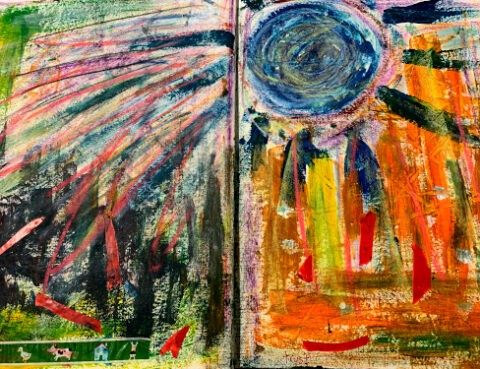
“Just make a mark,” Tammy said, as she boldly drew a messy line on her paper.
I had been the kind of girl who coloured between the lines. I wasn’t comfortable with things that were uncomfortable. Things I didn’t know how to do. Things that were messy. Yet something had been shifting and I knew there were things inside, things that didn’t fit between the lines, that wanted out.
“Just make a mark,” she said. And something in that statement melted for a moment the internal messages that had been keeping me captive. The ones that were whispering not so quietly, “Don’t you dare make any mark unless you know first that it is right!”
Let me back up a bit. I lived for the last few years on a little island known for the artists that inhabit it. One of them lived down the street and I got to know Tammy over soup and conversation. I admired her work — it was bold and raw and creative. But there was something I admired even more, and that was her ability to facilitate expressive art in others.
Permission. It’s a powerful word and an even more powerful construct. It holds the power to loosen things that have been stuffed or stagnant for years … decades even. When we experience permission, we open a portal. And if we let it do its magic, we are given a reprieve from holding in or holding back.
What about invitation? That’s a powerful word too. It offers something a little different than permission’s gentle “it’s okay.” Invitation has more of a “let’s do this!” kind of energy. “Let’s bring this to the table, or the wall, or the floor.… Let’s bring something IN you OUT into existence.”
Don’t we all long for this kind of invitation? And don’t we yearn to hear that it’s okay to be ourselves?
Well, when I met Tammy, I experienced both permission and invitation. Through her playful facilitation, she had me expressing things with paint, crayons, and other art supplies that I had been too afraid (or intimated by) to ever use. And she had me expressing it in a way that matched what was going on inside.
My friend Tammy, through her own transformative experiences, knew the secret was not about teaching the right technique or following a certain method. The magic came when she could create a safe place free of harmful messages. If she could do this, she was confident that the rest would unfold spontaneously.
But this requires a bit of space. Some freedom from scheduled activities and screens. Some freedom to try things out, to not get something “right” — the first time, or the second time, or maybe ever. Because maybe (you can probably guess what I’m going to say here), getting it “right” isn’t the goal worth aiming for. Maybe it should be more about getting it “out.”
In this space, you can trust that whatever comes out isn’t going to be held against you. And it’s not going to mess up your relationships or get you in trouble with the people you care about. In the play mode, there is both safety and freedom. I don’t know about you, but this is the kind of space I want to facilitate for those I care about. Yes, what comes out may be messy or loud. But the alternative is even more messy if it stays on the inside.
I’ve been sharing about my experience with emotional expression through art, but art is not the only way. There are so many beautiful outlets we have at our fingertips. We can even find them for free.
Music. Movement. Writing. Poetry. Drama. Story. Our culture used to hold these as sacred for us, so we didn’t even have to think about how they were serving us. But most of us have lost this cultural wisdom, and we are left to find our own way in bringing these practices back into our lives, and the lives of those we care for.
People sometimes ask me, how do I know if something is play? It may sound like a simple question, but it is not so clear cut. Those cultural outlets I listed above, those can be play; but these same things could also easily be turned into work. Cooking can be play, but if you have to get dinner on the table in five minutes to feed your family, it more likely feels like work in that moment. It is not the activity itself that defines something as play, but the way you enter into it.
If you are not sure, here are some guiding questions to help you discern:
- Does it feel like work? If you are focused more on the outcome than the process, you are likely operating out of the work mode and this won’t be a safe place for emotions to come out and play.
- Do you feel like someone is evaluating you? This could be a message (real or imaginary) coming from society, your parents, your partner, or more likely, your self. If you are feeling pressure to perform, this will not lead to the kind of playfulness that leads to expression.
- Do you feel like your guard is up? If you don’t feel safe, physically or emotionally, you are more likely in alarm mode, which again, will make it hard to find your play.
On the other hand, if there is room to try something without fearing repercussions or if you experience some freedom to say or do what you feel moved to say or do (or sing or scream), you may be in the good and trustworthy hands of Play herself. Trust her if you can. Her wisdom has been with us since the beginning of time.
And so, dear readers, I wish for you both permission and invitation. Permission to open the door, and an invitation to bring whatever is in there to come out. For yourself, for your child, and for anyone else who needs a little help finding the kind of play that will help them express what’s inside.
__________________________________________
Editors note: Tamara will be offering an opportunity to dive deeper in to the practice of facilitating play for others – whatever your role – starting online in February 2024.
For more information:
And to find out more about Tammy’s expressive art, you can find her at:
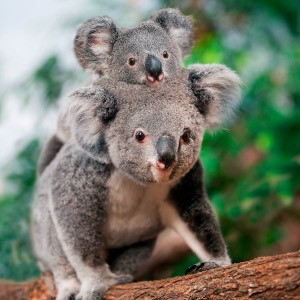
Sometimes in our travels we come upon something that seemed initially like just one more place to visit, only in retrospect to reveal itself as absolutely key to our understanding of the world and our place in it. I remember a few such transforming experiences in my life. My travels over the theoretical landscape of making sense of our children and ourselves as been similar in this regard. Initially it seemed to me that the subject of dependence was only one of a myriad of topics that pertained to today’s parenting and teaching. The deeper my immersion into the material however, the more convinced I became that our thinking about dependence couldn’t be more singularly pivotal, at the very core of our interactions with our children and indeed, our loved ones. Changes in parenting or teaching would not be truly effective and often not even stick unless these actions emanated from a deep invitation to our dependants to truly depend upon us.
I have also become convinced that being too direct or instrumental in our interactions with our children – goal-focused or outcome-focused as it were – has been our undoing in today’s society. We seem to have no reticence whatsoever in revealing what is on our mind concerning them, or what we want from them, or even what we have in mind for them. I have come to know Nature as deeply shy regarding its work and purpose, resisting exposure lest such consciousness sabotage the very conditions that are necessary to realize the desired results. I am sure this is why Nature disguises itself as ‘play’, for example, giving the illusion that it is ‘up to nothing in particular,’ so that it has the room it needs to work its developmental magic. As Nature’s agents in the lives of our children, it should be no different for us.
We have eschewed the dependence of our children for far too long now – for generations if not centuries, especially in so-called enlightened societies – with societal results that are deeply concerning. It is high time to return to our senses – that is, to trust and to lean upon the spontaneous and benevolent life force that is yearning to bring to potential our children, and through them, a society that is not crippled by immaturity.
Editor’s note: The Wisdom of Dependence was the topic of this year’s annual conference in April of this year. Dr. Neufeld only had enough time to share a small portion of the material he had prepared on this topic. Given the timely and critical importance of this subject, we decided to walk it out this Fall in a series of four webinars which include a short presentation by Dr. Neufeld followed by a panel discussion where he is joined by a few of the Neufeld Institute faculty. We invite you to watch this short preview video and join us for the entire series.

I lost my playfulness pretty early in life. Something to do with figuring out there was a “right” way to do things, or that I was easier to manage without my big bright and often messy ideas. Either way, it became obvious to me that taking risks was too risky and I would get further in life if I could figure out what others wanted and meet those expectations.
Maybe some of you can relate.
It’s rather an exhausting way to live, with little room for mistakes, and not a lot of room for questions. If yellow was the colour of playfulness and curiosity, I had lost it somewhere along the way to adolescence and by adulthood, my world was pretty black and white. I dare not sing lest someone find me off-tune. I dare not draw or paint or act or … well, anything that might show my lack of “talent”.
Fast forward some years to where I find myself with young children of my own. Still very driven and outcome-based, I started to occasionally catch glimpses of yellow again, finding joy in reading bedtime stories out loud and playing with the characters’ voices, or singing songs to my girls (who seemed oblivious to whether my pitch was perfect or not). I found myself envious at times of their ability to enter into free play as I watched from a distance, for it seemed to come so easily to them.
Ever so slowly, the yellow began to find its way back into my life — through my children’s laughter, the magic of spinning wool into yarn, the absurdity of chickens dancing on the lawn. I’m not sure if there was ever a full arriving moment … it was more of a gradual recovery and remembering until playfulness simply became a way of life.
Until I lost it again.
There are times in our lives when something can happen that upends us: a relationship break-up, a diagnosis, the loss of some thing, some place or some one we hold dear. This can happen at any age. At any time. We can lose our playfulness in those moments (or months). Our body retreats into survival mode and peddles hard just to keep some semblance of order and normality. Anything playful feels frivolous, or ludicrous, or inappropriate.
But what if this is when we need play the most??
This is where I find myself coming back to time after time — finding play, losing play, needing to find it again.
At least find the edge of it. In the melancholy of a song, on the pages of my journal, in a piece of art, in the shade of a tree, in the gush of a waterfall. Something that takes me for a moment out of my head, out of my alarm, and into a place that travels sideways to my heart. Not a direct route, that would be too much.
Something that allows me to play at the edges a bit. Dip my toes in the water. Dabble in the sadness. Dare something to move again. For it’s in the movement that we feel most alive. It is the movement that saves us in the end.
And so, if you find yourself, like me sometimes, at a loss for play, I suggest seeking out the edges.
Make a date with the trees or the lake or the rose bush outside your window. With a song or an instrument or the faltering sound of your own voice. With a paintbrush or a crayon or a fountain pen. With a book or a movie, a story that allows you to enter in and connect with what’s inside and wants out to play.
And maybe invite someone else along for the ride. For as I learned many years ago when my children were younger, sometimes it is in the act of helping someone else find their play that we stumble into our own.
Editor’s note about the Playful Facilitation Module – February to May 2024
Tamara Strijack is delighted to be offering something new and outside-the-box next year. Building on the material of the play series, this will be a five month online experiential course module that focuses on facilitating true play in the lives of those in our care (including ourselves). Whether you are an educator, a helping professional, a parent or a mentor, this will be an opportunity to explore ways to both subtly and intentionally harness the power of play and the play mode, and (hopefully) restore our own playfulness in the process.
This course of study will be offered in partnership with the Yellow Door, a new centre founded by Tamara that brings developmental science into an experiential practice of learning and becoming. It will run biweekly on Thursdays from 9 am to 11 am Pacific Time, starting in February 2024. Registration is now open.
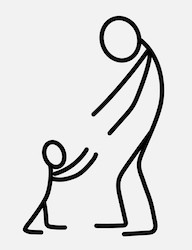
As I have been immersing myself into the material in preparation for my 2023 conference address on the Wisdom of Dependence, I once again find myself in awe regarding Nature’s blueprint for the unfolding of human potential. At the same time, I am acutely aware of how much we are still being governed by the tired doctrine of self-sufficiency, especially when it comes to raising children. We are still preoccupied with pushing independence upon them, succumbing to one variation after another with some of the newest obsessions including self-soothing, self-regulation, and self-care. So many adults are still living by the adage that we must not do anything for a child that they could or should do for themselves, and so strive towards their independence and self-sufficiency while dangerously sacrificing their dependency needs for togetherness in the process. We are still operating in our society as if a spontaneous life force does not exist, never mind that it is ready and eager to do its work once we show some promise of doing ours.
For generations now – at least in the dominant English-speaking society – we have thrown dependence under the bus, sacrificing it in our efforts to train independence. When our efforts fail as they inevitably do, we foolishly double down. We should not be surprised to have given rise to the most insecure and troubled children ever.
What is required to wrench ourselves free of this infected mindset? To realize how incongruent this approach is to developmental science? How can we get the confidence to swim against the stream of prevailing practice?
It strikes me that even though we may have had a glimpse of the true nature of Nature, we may still need to be reminded, perhaps time and time again, of how Nature works and that the instinct to depend is there for good reason – in fact for several good reasons. Perhaps we need to be refreshed on the wisdom of Nature to permit ourselves to lean into it, to depend upon it, especially when encountering dependence that seems overdue.
I have gathered enough material now to write a book about the wisdom of dependence, but knowing me, this is not going to happen, at least not any time soon. My challenge now is to distill the material to its essence in such a way that would instill the confidence required to take the leap of faith of inviting our dependants to depend upon us, trusting that, if we can get our caring through to them, Nature will do what only it can do: grow them up to be their own persons.
I am convinced that unless we can DEPEND upon Nature, we will not be inclined to invite our children to DEPEND upon us. And unless we can invite them to DEPEND upon us, Nature will not be able to raise them to their potential, including their full potential as separate beings. Relying upon Nature makes parenting so much easier than carrying the whole load ourselves. It doesn’t need to be this hard!
I am also convinced that this is the most important and pivotal issue in parenting and teaching today, bar none. I tried to speak to it ten years ago in a two-minute segment, “Kids and Independence”, for Kids in the House. I will try again, this time with more time, in the opening address for this year’s annual conference.
Editor’s note: Gordon will present of Wisdom of Dependence at Neufeld Institute Conference 2023 on Saturday, April 22, 2023. Registration includes access to all recordings for 90 days.
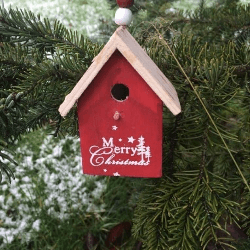
This Winter, as the light dwindles in the Northern hemisphere and winter holidays approach, we here at the Neufeld Institute – faculty members and facilitators -would once again like to offer the gift of stories to you. This batch of holiday stories, our third annual collection, features stories about the incredible power of intentional togetherness. Deliberate and preserved family time has the power to transcend changing circumstances (Tamara), the power to connect in spite of the daily ups and downs (Bree) and, finally, in Karen’s story, we can witness the power of loving ritual to transcend even the greatest separation we ever face.
In this first story, Tamara Strijack describes how a newly created family activity, when done with care and intention, can evoke the same feelings of joy and togetherness as old ones did:
December always felt like a bit of a challenge for me. The question loomed large: how do I preserve meaning and connection in this season that seemed to become more about commerce with each passing year? But when my husband and I separated, this became an even greater challenge. Our family traditions were no longer something we could all count on. Where was the glue? It felt like things could easily fall apart. In the chaos of those first few years, I realized that as some of our old traditions were lost in the break-up, my girls and I needed something new to orient around. And so, Christmas tacos were born. A bit odd and unlikely perhaps, as traditions go, but those tacos gave us something to hold on to.
I remember that first transitional year when my girls and I had our first Christmas in our new family configuration. Inspired by a special taco night with extended family over the summer, we decided that this was going to be our thing. And so we prepared the seasoned jackfruit, the shrimp, the roasted yam, the cheese, the guacamole and of course, the much beloved baja sauce (my brother’s special recipe!). We laughed together in the kitchen and took our time – because it was just as much (probably more) about the togetherness in preparing as it was the eating of the tacos (which were incredible and worth waiting for!!). And as it turns out, you only have to experience something special once to create the intention for it to become a regular thing. It was the beginning of a new rhythm.
The important thing? We are doing this together, my girls and I, and are forging new memories, while still remembering and honouring what has come before. Not an easy balance to hold. But an essential one. Now to find the perfect avocado …
In our second story, Bree Jordan, describes how her family’s cozy reading time provides a bridge of connection over all the inevitable ups and downs that come with each day:
Our “family reading” tradition began four years ago when our children were four and seven. It is something that we do year-round but, in the cold of our Canadian winters, the appeal of the warm blanket, a snuggle and an engaging tale is all the more enticing. We were homeschooling at the outset of our family reading adventures and I felt compelled to read them the classics. I worried about asking the children grade level questions that I had researched on teacher’s blogs online. However, I could tell it was becoming a chore and the joy was being leached from the story, so we ditched one of my personal favorites, “The Secret Garden” and started a fantasy series. The children did not want me to put it down! There is such a connection in this shared experience. The inside jokes, the interruptions to dispute the feasibility of a character’s plan, “They should have done this”, “Imagine if they did that!” were spirited and playful. It was such a powerful connecting activity that their dad started to feel left out and set about reading the same series to the kids over again. We found that we could impart our values and talk about life, love, disappointment and even death in a way that maintained connection and was not too hard to look at. We read myths from around the world and developed family travel fantasies and a deeper understanding of different cultures. When attempting to recover from events of sibling rivalry or in times of high stress, our family reading ritual lightens the load and provides an easy way to fall into connection again.
Finally, Karen Bollman, describes the way she and her brothers continue to connect with their mom each Christmas, illustrating the power of love and ritual to keep us connected always:
My mom’s favourite time of year was Christmas. She loved going to Christmas stores that had dozens of decorated trees, each bough bursting with a specific theme or colour coordinated ornaments. The list of special people she wanted to choose the perfect ornament for grew every year. Once her shopping was complete, she would present the ornament with a hand knit dishrag as an extra special touch.
Everyone knew her love for Christmas, so it made perfect sense that she was put in charge of decorating the hotel she worked at for over 20 years (some of you may be familiar with The Bayside Inn in Parksville). My mom created her own themed trees – blue and silver, white or red, and her favourite tree was packed full of shimmering golds.
When my mom passed away, my brothers and I split up her Christmas decor. I took her tree. It seemed fitting because when I was a teenager, I often decorated our tree for her. She worked long hours and despite some of our mother/daughter conflict, there was nothing like seeing her face light up when she walked in the door. Each year, I look forward to decorating her tree in my own home. My kids and I stuff each branch full of ornaments past and the new ones we picked from one of those Christmas stores she loved.
As a final gift to her memory, we had a beautiful blue spruce planted in her honour. Every year, my family meets at her tree to remember her, to honour her love of Christmas, and to fill each branch with handpicked ornaments that represent how special she is to us. It has been the most beautiful way to hold onto her while apart, and to connect her grandchildren to her heart.
This is one of my favourite ornaments pictured on my mom’s tree. She also loved the snow.
Whether this time of year finds you enjoying familiar beloved rituals, feeling the need to create new ones or, possibly, feeling the loss of familiar rituals or of loved ones, we hope you can find a small intentional way to connect with yourself and with those you love.
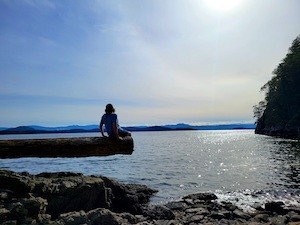
Oh my … how a heart can stretch when it gets to love something. When it really, excruciatingly loves, in a nonsensical, absolutely unreasonable kind of way. There are other ways to find it of course, but our children are especially magical at evoking this particular breed of love. It’s the kind that is needed to survive the previously unimaginable, unendurable combination of a screaming babe and endless sleepless nights, and the wild contrary toddler stage, and the first time that you look at your little kid (now not quite so small) and realize that you can’t solve all of his problems anymore.
And when he starts nearing adolescence, and you’ve made it through all of the skinned knees and the heartbreaks of losing a pet, or a friend, and he starts to talk with you about his ideas, or the way he saw this situation or that flower, and you take a deep breath and sigh and think, we have arrived. And you think, foolishly, because he’s your first child, that this explosion of consciousness will make life so much simpler. Because his dependence is blossoming into independence before your eyes, and that must make things easier, right? It must.
Foolish indeed.
As he gets older, you get older too, and with any luck, by the time he’s getting into his teenage years, you realize the truth: there is no arriving. And if you weren’t already getting to this idea on your own, he’ll help you. There is only, as they say in these videogames that he likes to play, levelling up. So far, you’ve risen to every occasion that he’s thrown you with varying degrees of elegance; but you’re in the big leagues now.
Some days, it seems that all he wants to do is complain about things that he finds annoying (almost everything). All he wants to talk about are cars and videogames (or insert a couple of things that you know, and care, almost nothing about), or more challenging still, things that you find provocative or taboo. He says things that make you question whether you were successful at passing on any of what you value most dearly. And just to further provoke, you can’t look away from how all these things come along with the rest of what it must mean: how can you allow him out in a world where the prevailing belief system is so off-kilter? How can you allow him to participate in popular culture where all that you have is the relationship that you’ve built with him, but no genuine control? You consider yourself progressive, forward-thinking – but you find your traditional upbringing rearing its hard head as he pushes on you and so much of you just wants to push back, or pack up and run for the hills to find a place without cell service or wifi.
How do you ask your heart to expand to encompass all of this? How do you hold on to him in the face of it all, with every button pushed, every reaction coiled and ready to spring?
Perhaps you’re not surprised that this is a personal story for me. I have found myself wrestling with these things over and over again in the past year as my son stepped into his adolescence. And I spent a lot of time thinking about the idea of coming alongside; because how could I possibly come alongside this? When the this that my son was bringing to the table was provocative, personal, unapologetically digging right into the heart of some of my dearest values. Surely, when Dr. Neufeld spoke about coming alongside, he didn’t mean this.
But he did. And I needed to allow this human who I love beyond reason to stretch my heart past the point of comfort, allow it to be changed, reshaped by the magic that coming alongside holds for both people. My beautiful son was floundering after going to sleep in his childhood bed and waking up abruptly in the ocean of adult consciousness. Of course he was grabbing onto anything that seemed like it might be a lifeline so that he wouldn’t drown in all the new ways that he himself was expanding. I needed to get truly solid, to become – and remain as much as possible – the unwavering, rooted tree to which was tied the one lifeline that would remain when the others proved false, or couldn’t bear the weight. I needed to not let the details distract me and hold resolutely to my trust that there is a way through even when I feel blind or furious or, worst of all, helpless; that he is finding, and will find, his way. I needed to expect the mess and the mud and the mayhem; expect it all, and start dancing.
For me, this was a radical idea. My Mennonite roots taught me much more about repressing or punishing the hard things than about coming alongside them (never mind that dancing itself was, for a long time, scandalous and forbidden). But I could feel the intuition in it despite my upbringing, and I could feel something taking shape.
So enter, radical coming alongside: the day we climbed a mountain and I devoted myself to not shying away from any subject, promised to meet him exactly, exactly, where he was at. I would stake my heart wide open and let myself breathe in the scent of fir trees and the beautiful, prickly, irreverent soul of my beloved adolescent.
And what did he want to talk about for most of that hike? Naturally, as though he knew the task I’d set myself, he wanted to talk about a first person shooter videogame that he had started playing.
What a test of my devotion, driving a nail straight into my pacifist roots. But I held on tight to my connection to him, this person who I love most; I pushed into the discomfort and gradually, miraculously felt the content of our conversation depersonalize as my belief in the solidity of our relationship revealed itself. Instead of feeling triggered by the subject, I felt a boundless compassion for him. This conversation, the one that I didn’t want to have, turned into such a gift; I listened deeply enough to ask real questions, felt into the nuances, and he gradually opened up, responding to my genuine curiousity and softness with his own. As we descended the other side of the mountain, almost at our destination, he talked around his mixed feelings about the game; the things he found appealing, the things he found uncomfortable, the places he felt pushed, his desire to fit in, his yearning to be different.
I was humbled by what he shared with me. I hadn’t realized how much I wasn’t allowing by not being willing to engage with these subjects that pushed on me; I hadn’t realized that the pushing was actually an opportunity for my heart to grow. I could have missed out on this whole exquisite exchange, and all the ones that would follow.
That day, I could feel the hunger in him for this very conversation, and for the others that I hadn’t been willing to have; my discomfort with the subject matter had caused a kind of insatiability in him, and though I struggled with the regret of that, I knew with certainty that it was not the dreaded “too late.” All I had to do was keep being willing to jump into the mud with him. No matter what, our kids will meet us in the mud every time – their generousity here is endless. And it may be the finest place for a tea party.
And what happened when we got to our destination, on the other side of that mountain, to the place we love next to the ocean where we can watch the ferry go by? We lay on our stomachs for hours, my almost-fourteen-year-old and I, and watched the tiny worlds that exist in tide pools. We played games with found treasures. We laughed. Not another word about videogames was uttered.
He was at rest – we were both at rest – on the other side of a small big thing. Maybe a big small thing. I could see from the quiet joy in his eyes that he felt that lifeline that was connecting us, that it felt sure and tangible, shining and true.
This is not the end of the story. We will never arrive. There will always be more mud. Some days, the best that I can do as a mother is to come alongside the fact that I don’t want to come alongside right now. That happens. It evolves as it does. And there’s grieving to do; all the things that I can’t make ideal for him, can’t fix; that I can’t directly protect him from mainstream society, from the influence of the culture of people without a culture. Like the mud, I no longer expect this grief to end. My job is to make sure that the lifeline between him, out splashing around in the water, and me, increasingly rooted, is stronger than the other lines reaching out to him. Holding onto the thread of our relationship: that is the through-line. That commitment to hold onto him even – especially – when he lets go of me, that will see us through all of the storms and mud puddles.
May our hearts be like our noses – may they never stop growing. May they boldly wear the pits and scars of the tough times, and be stretched beyond recognition of the unobtrusive, polite things that they used to be.
